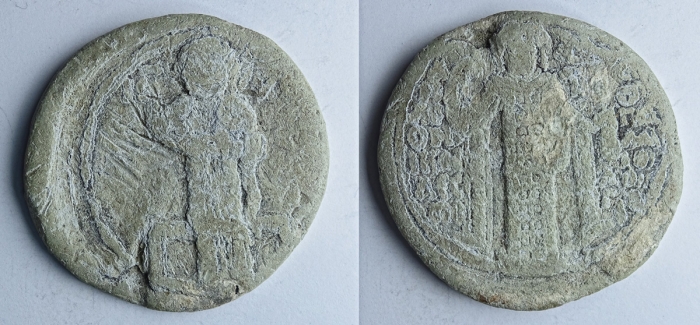Lead seal of Emperor Andronicus II Palaeologus

The second imperial seal in the collection of the Burgas museum belongs to the Byzantine emperor Andronicus II Palaeologus (1282-1328). The seal has been published twice, the first publication stating that it originates from the Burgas region, and the second publication stating that it is unknown. In fact, in the inventories of the Burgas Museum the seal is described as found during works on the Burgas Mineral Baths in 1906 - the ancient city of Aquae Calidae, the medieval Thermae.
The seal is dulled and in an advanced degree of corrosion. On its obverse there is an image of Christ standing opposite on a supedion (footstool), wearing a chiton and himation, with his right hand he blesses and with his left holds the Gospel. The reverse side of the seal depicts Emperor Andronicus II Palaeologus with a crown, division and loros, with his right hand he rests on a scepter with a long handle (labarum), and with his left he holds an acacia (a small cloth bag with soil). On both sides of the image is a vertical inscription in Greek: Andronicus Palaeologus, despot.
Two more seals of Andronicus II Palaeologus with a certain location are known from Bulgaria. One them is from the medieval fortress Tsepina in the Western Rhodopes, and the other is from the village of Chereshitsa, Kardzhali region. The numismatist V. Penchev suggests that the seal of Andronicus II Palaeologus from Burgas (actually from the Burgas Mineral Baths) could be related to the military actions between Byzantium and the Second Bulgarian Kingdom in 1304, when the two countries fought for control over the southeastern Bulgarian lands.
Written sources and archaeological research show that the medieval city of Thermae and the mineral baths were ravaged and burned in 1206 by the Crusaders, led by the Emperor of the Latin Empire, Henry of Flanders.
The baths are thought to have continued to function in limited form in the 13th century, yet there is no evidence that they were used in the 14th century. The seal of Andronicus II Palaeologus from Aquae Calidae amplifies the known archaeological and numismatic materials in this direction and in particular for use in the late 13th- early 14th century.
Author: Yoto Yotov
